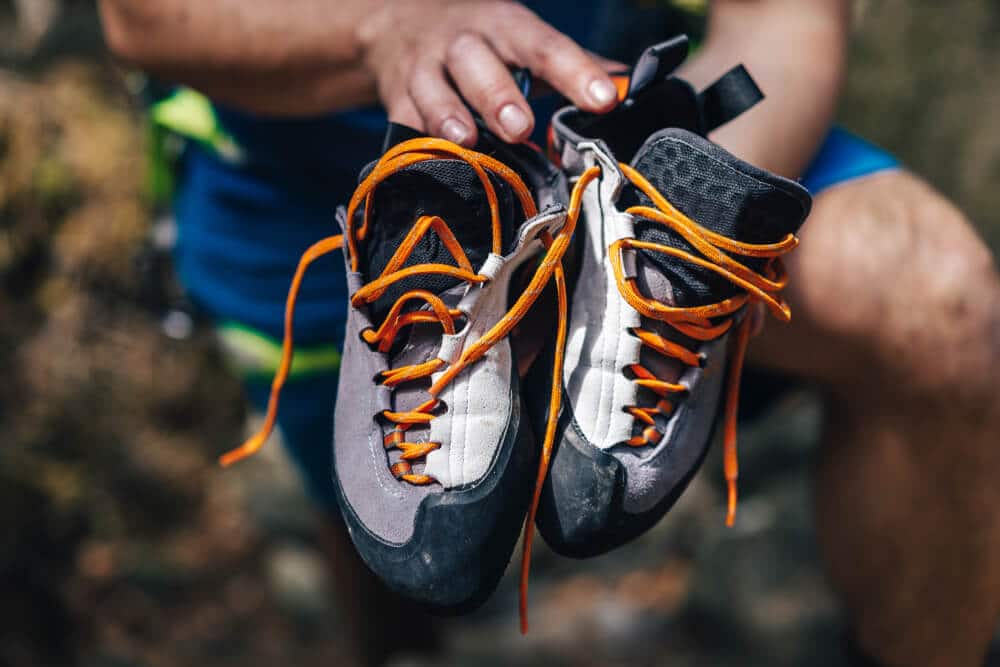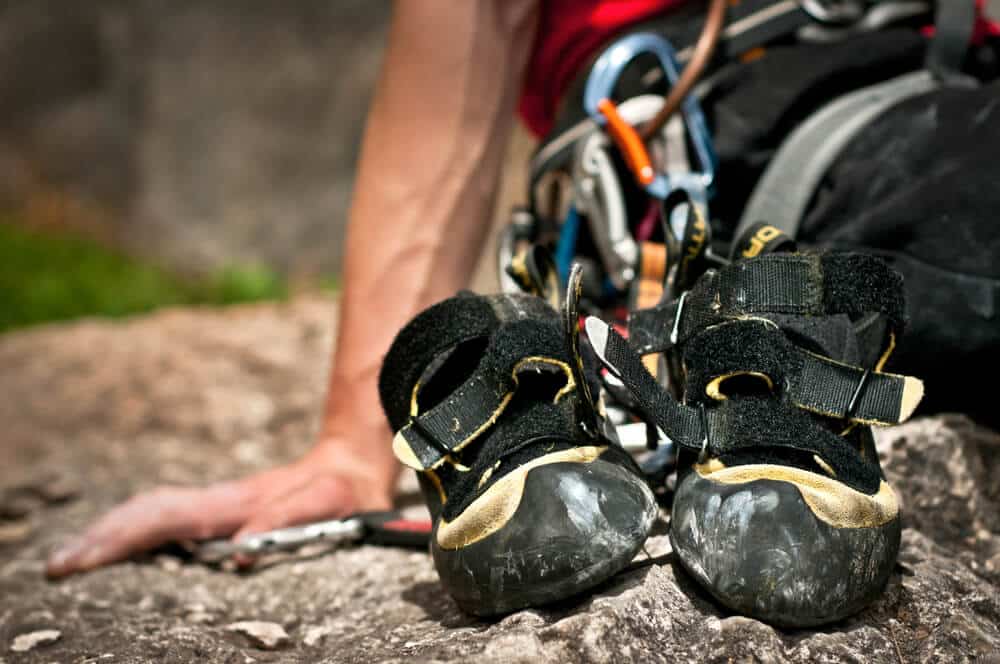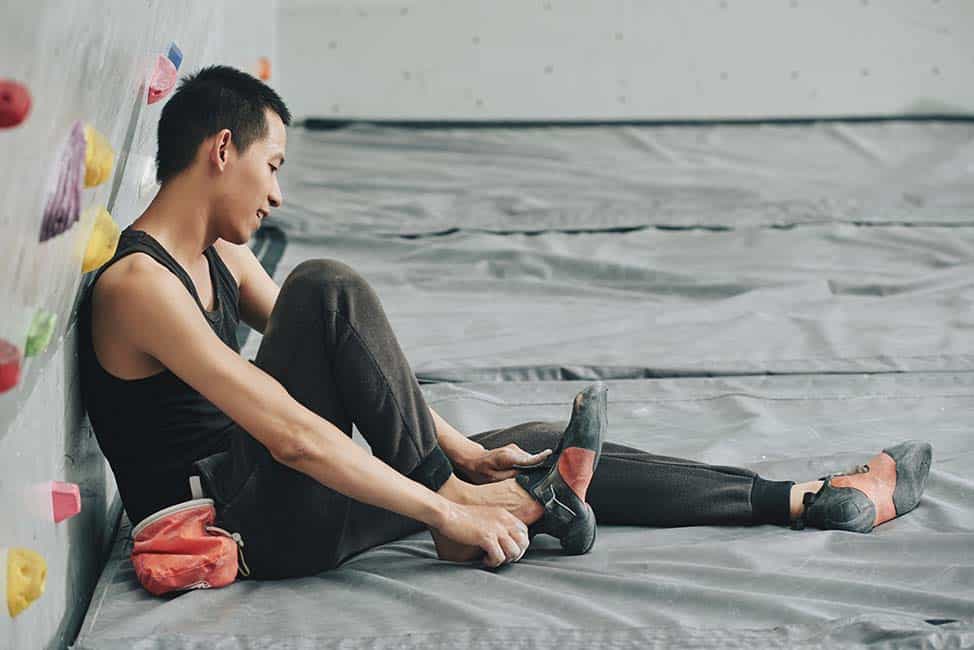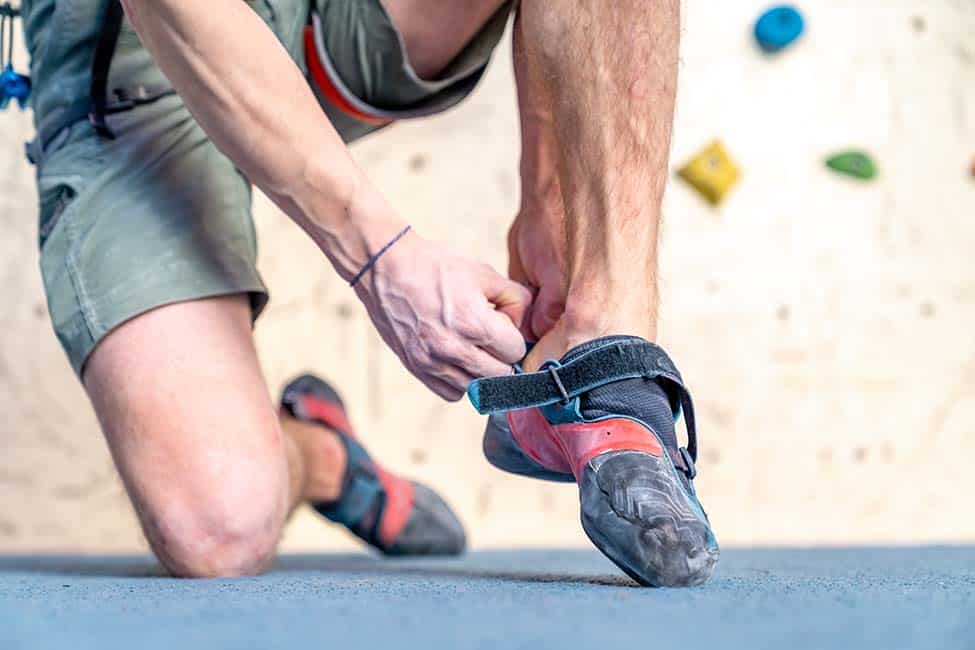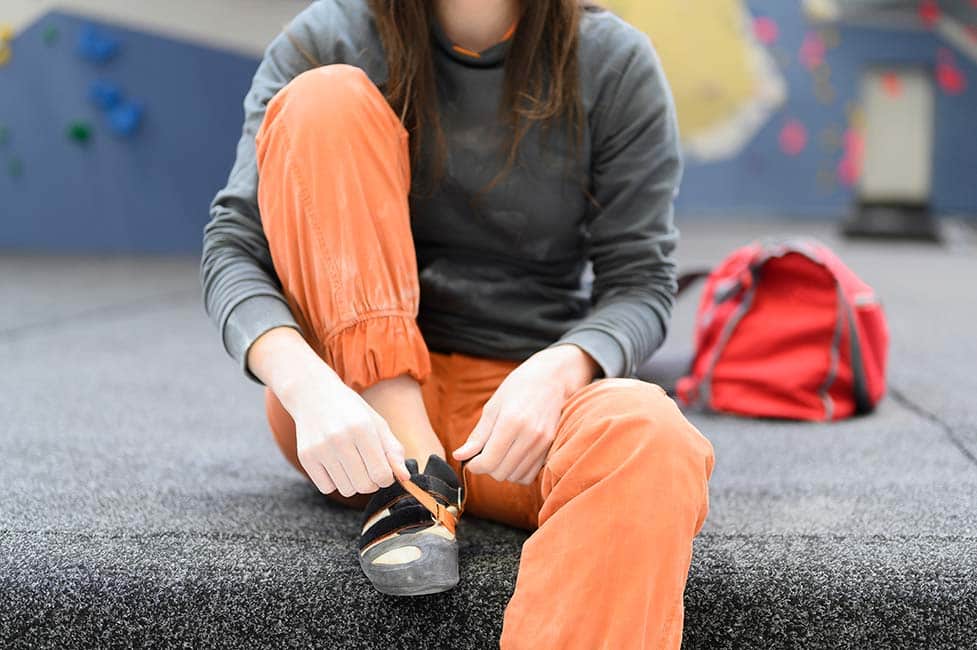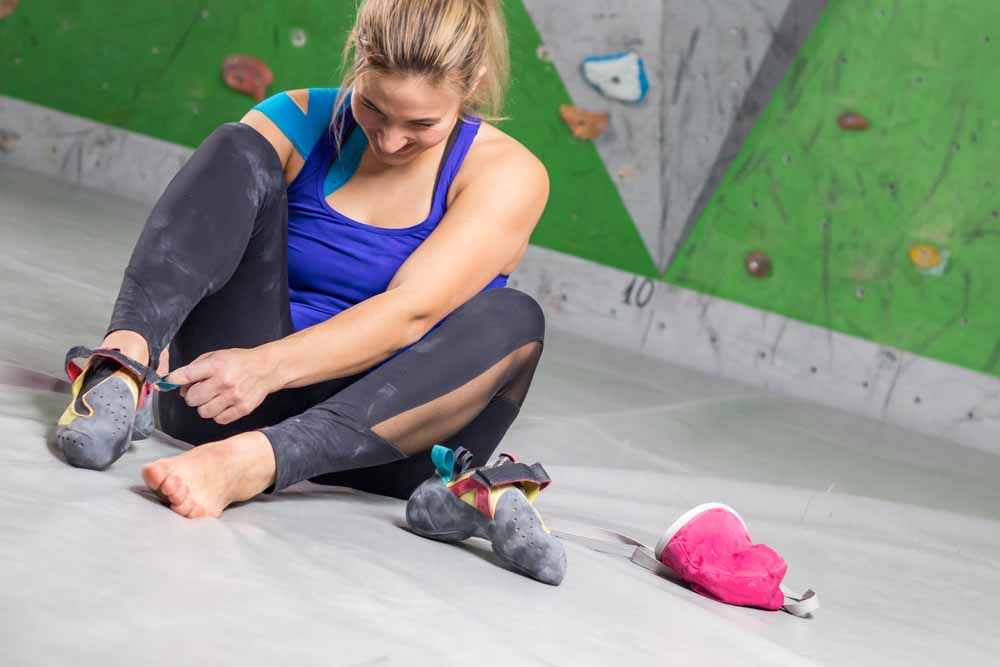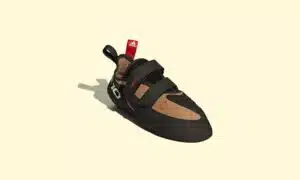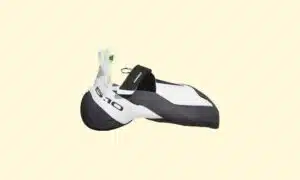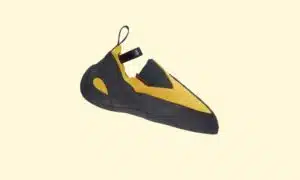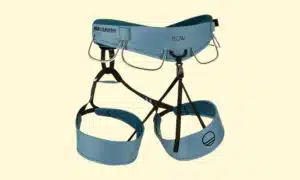Choosing a pair of rock climbing shoes is still an important process, and it’s likely the first purchase you’ll make as a beginner climber.
Climbing shoes may not play a role safety in the same way ropes, helmets, and harnesses do, but your climbing shoes are the single most important piece of equipment when it comes to performance on the wall. This is true whether you’re bouldering in the gym, sport climbing at your local crag, or on a 1,000-meter alpine big wall.
In this guide, I’ll break down the components of a standard climbing shoe, and talk about the big differences you’ll see between shoes: closure system, material, and level of aggression. Then we’ll have a detailed breakdown for how to choose climbing shoes based on your climbing experience and skill level (beginner, intermediate, or advanced).
The Components of a Climbing Shoe
Upper
This is the top part of the shoe that encases the foot. It’s typically made from leather or synthetic materials. Leather uppers tend to stretch and mold to the climber’s foot over time, while synthetic materials offer less stretch but greater consistency in fit. Some uppers are perforated or have mesh panels to improve breathability.
Midsole
Located between the sole and the upper, the midsole is what you stand on. It provides support and stiffness to the shoe. The midsole’s thickness and material affect the shoe’s sensitivity and stiffness. Stiffer midsoles facilitate better edging, while more pliable or thin midsoles improve sensitivity.
Outsole
The outsole is arguably the most critical component of a climbing shoe. This is the sticky rubber surface on the bottom of your shoe that comes into contact with the rock. The thickness and stiffness of the sole can vary: thinner soles offer more sensitivity and better feel of the rock, whereas thicker soles provide more protection and support for the foot and also last longer. (The outsole is typically the first part of your climbing shoes to wear out, with holes to appear in the toe or forefoot after extensive use.)
Rand
The rand is a layer of rubber that wraps around the front of the shoe, the sides, and the heel. It’s basically additional rubber coverage on surfaces beyond the normal outsole. It provides rubber for toe and heel hooks, protects the upper material from abrasion, and gives manufacturers a base to glue the outsole to the shoe to minimize delamination. Shoe models designed for crack climbing feature particularly heavy rand coverage.
Tension in the rand also contributes to the shoe’s overall fit and performance, with more aggressive (downturned) shoes having tighter rands to support the foot in steep terrain. There are various types of rands, mostly brand-specific. One common design is the “slingshot” model, which entails a single piece of rubber wrapping around the back of the heel down to the forefoot, increasing forward power.
Heel Cup
A shoe’s heel cup is designed to fit snugly around the heel, providing sensitivity and grip during heel hooks. The design and rubber coverage on the heel can vary, affecting comfort and performance during heel hooking scenarios.
Toe Box
The toe box is the front part of the shoe. Most climbing shoes are designed to concentrate power to the forefoot and toes for precise foot placements. The shape and volume of the toe box can significantly impact performance, especially in terms of edging ability and comfort.
Climbing Shoe Closure Systems: Lace-Up vs. Velcro vs. Slipper
Climbing shoes come with three different types of closure systems: laces, Velcro (hook-and-loop straps), and slip-on, or “slipper” closures. Some shoes also have hybrid closures, with a small lacing harness augmenting a primarily slip-on closure, for example.
There are pros and cons to each closure system.
Lace-Up Shoes
Laces offer a customizable fit, allowing adjustment of tightness across different parts of the foot. They’re usually the most comfortable closure system, letting you tighten and loosen your shoes as the day goes on. Lace-up shoes are popular in a variety of disciplines, but particularly for trad climbing, multi-pitch climbing, or other outdoor scenarios where all day wear is common. The two downsides of lacing closures is that they make the shoe slower to take off and on and that the lacing harness can be bulky, obstructing certain foot movements, like toe hooks and jams.
Velcro Shoes
Velcro straps are perhaps the most popular closure system, offering a blend of adjustability and ease-of-use. Some shoes have a single Velcro strap married with a slipper closure, some incorporate as many as three individual hook and loop Velcro straps. The primary advantage with Velcro is that it makes it quick and easy to slip shoes on and off and still offers some of the customizability in fit that is provided by laces. Velcro shoes are popular for bouldering and gym climbing, as well as sport climbing.
Slip-On Shoes
Slippers or slip-on climbing shoes use an elastic closure system to allow you to slide the shoe off and on. Despite how this might sound, slippers are usually a bit harder to get off and on than Velcro. They’re favored primarily for their snug, seamless fit, minimal bulk, and high level of sensitivity. Slippers are also advantageous for crack climbing, as there is no closure system on the upper to obstruct foot jams.
Leather Shoes vs. Synthetic Shoes
Almost all climbing shoe uppers are made either leather or synthetic hybrids. Like closure systems, leather and synthetic uppers have different pros and cons.
Leather
Leather uppers are typically more durable, breathable, and comfortable, but stretch overtime. There are two types of leather, lined leather and unlined leather.
Unlined leather climbing shoes offer the most stretch and natural feel, molding closely to the foot’s shape. This can result in a very comfortable fit after a break-in period. The downside is that they can stretch out too much if not sized correctly, potentially leading to a less precise fit over time. Unlined leather also offers the best breathability, making them a good choice for long sessions or warm conditions.
Lined leather climbing shoes feature a lining inside the shoe to limit stretch and provide a more consistent fit over the shoe’s lifespan. The lining can be made from various materials and may only cover certain parts of the shoe to strategically control stretch. They’re a good middle ground for climbers who want the comfort of leather without too much change in the shoe’s fit.
Synthetic
Synthetic uppers minimize stretching, offering a more stable and precise fit that changes very little over the lifetime of the shoe. They’re also the only choice for animal-conscious or vegan climbers. Synthetics are usually less breathable than leather, though this really depends on the synthetic blend used by the manufacturers.
Aggressive Shoes vs. Neutral Shoes
Climbing shoes are categorized along an aggression spectrum, which is primarily delineated by two factors: symmetry and downturn. Symmetrical shoes are typically flat, while asymmetrical shoes are typically downturned. A combination of flat and symmetric features makes for a “neutral” shoe, while downturn and asymmetry makes for an “aggressive” shoe.
An aggressive shoe is typically higher performing, but usually more expensive and less comfortable than a neutral shoe.
Symmetry vs. Asymmetry
Symmetric climbing shoes have a straight shape that mirrors the natural line of the foot. They distribute pressure more evenly across the foot, leading to greater comfort, especially in longer climbing sessions or when wearing the shoes for extended periods.
Symmetric shoes are generally preferred for traditional climbing, crack climbing, and climbing scenarios where comfort is prioritized over performance. They tend to have a flatter profile, making them well-suited for slabs and vertical faces where edging and smearing are common.
Asymmetric climbing shoes feature a design where the toe point is skewed towards the big toe, creating a curve. This design concentrates power on the toe for more precise foot placements, enhancing performance on steep terrain, small holds, and pockets.
Asymmetrical shoes often come with a downturn (see below) that adds power on overhangs. The asymmetry allows climbers to apply force more directly and with greater precision, but can be less comfortable than symmetric designs, especially for beginners or during prolonged use.
Flat vs. Downturned Shoes
Most climbing shoes feature some amount of downturned shape, which means the toe area curves down towards the ground. This design helps in focusing power on the toes, providing an advantage in steep or overhanging terrain. The degree of downturn varies among models, from flat to moderate to aggressive.
How to Choose Beginner Climbing Shoes
Choosing your first pair of climbing shoes is a pivotal moment in your climbing journey, impacting both your comfort and your ability to learn and progress in the sport.
That said, don’t stress too much.
Unlike most other climbing gear, particularly hardware, climbing shoes don’t last years and years. You’ll probably burn through your first pair of climbing shoes in six months at most. A focus on comfort, above all else, is key for your first pair of shoes.
Comfort is Key
Fit: Unlike advanced climbing shoes, beginners should prioritize comfort over performance. Look for a snug fit, with your toes close to the end of the shoe without curling, allowing for precise foot placements without causing pain.
Volume and Width: Pay attention to the volume (the overall internal space of the shoe) and the width to ensure a good fit for your foot shape. Some brands offer models in low-volume versions for women or men with narrower feet.
Opt for a Neutral Profile
Shape: Beginner shoes typically have a flat (neutral) profile, which is more comfortable for extended wear, easier to adapt to, and more versatile for slabby and vert terrain. This design helps in building foot strength and technique without relying on the aggressive shape of more advanced shoes.
Versatility: Neutral-profile shoes are versatile, performing well on various types of climbs, making them ideal for beginners who are still exploring different climbing styles and terrains.
Closure System
It’s hard to say what type of closure system is best for a beginners shoes. It really depends on your preference (we discuss closures above). Most beginners opt for Velcro closures, but there are plenty of lace-up shoes, like the La Sportiva Tarantulace, that are also great for new climbers.
Thick Rubber
Your first pair of climbing shoes should have relatively thick rubber (5-6mm). Thicker rubber soles offer more durability and support, which can be beneficial for beginners still developing technique. Thicker rubber also lasts longer
Price
As a beginner, focus on affordable options ($100 or less), as your climbing style and preferences will evolve as you gain experience.
More Tips for Beginner Shoes
- Try Before You Buy: If possible, visit a store to try on multiple brands and models. Climbing shoe sizes can vary significantly between manufacturers.
- Don’t Wear Socks: There is no reason to where socks with climbing shoes. They dramatically reduce sensitivity and make it harder to find a precise fit.
- Consider Future Stretch: See above section about upper material. Leather shoes will stretch; synthetic ones will not (much). Ask experienced climbers or store staff about how much a particular model might stretch.
How to Choose Intermediate Climbing Shoes
I’ll be briefer here, since we’re covering a lot of the same ground. For an intermediate climber (your second or third pair of shoes) there are a few considerations.
Slightly Aggressive Profile: Look for a moderate downturn that offers precision on smaller holds and steep terrain without sacrificing too much comfort.
Price: Intermediate shoes are pricier than beginner shoes. Expect something between $120 and $190.
Fit and Comfort: Aim for a snugger fit than beginner shoes, but not painfully tight. Your toes should be slightly curled, with a slightly asymmetric shape to concentrate power on the big toe for precision.
Rubber: Intermediate climbers can benefit from slightly thinner rubber (~3-4mm) for better sensitivity.
Versatility vs. Specialization: As an intermediate climber, you may have been climbing long enough to have a preferred climbing style (e.g., crack, slab, roofs). In that case, look for shoes that excel in those areas. Otherwise, a versatile shoe is still a good choice as you refine your skills and preferences.
How to Choose Advanced Climbing Shoes
Most advanced climbers will have an idea of what they’re looking for in a shoe, but here are a few considerations.
Aggressive: Aggressive shoes are popular for advanced performance climbers. Choose shoes with a pronounced downturn and asymmetric shape for optimal performance on overhangs and precise footwork on small holds.
Precision Fit: Advanced shoes should fit very snugly, with toes curled tightly to maximize power transfer to the toe tips. Comfort is secondary to performance, but the fit should not cause injury.
Upper Material: Preference plays a big role; however, high-end models often feature sophisticated blends of leather and synthetic to offer the best of both worlds: stretch where you need it and stability where you don’t.
Rubber: Opt for softer, stickier, thinner rubber for maximum grip, even though it may wear down faster.
Specialization: At advanced levels, most climbers have multiple pairs of shoes for different types of climbs (e.g., steep bouldering, techy sport face routes, or slab climbing).
Frequently Asked Questions
What shoes to wear first time rock climbing?
Popular beginner climbing shoes include the Evolv Defy, Black Diamond Momentum, and La Sportiva Tarantulace. Choose climbing shoes that fit snug, but are comfortable.
How do I know if my climbing shoes fit?
There should be no dead space in your shoe, both at the forefoot and heel, with toes snug in the toe box (either flat or comfortably curved), without pain. Overall comfort will depend on how much you’re willing to sacrifice for performance.
Should you size up or down for climbing shoes?
This depends on the brand. For some brands (La Sportiva) you should size down, others (Five Ten) you should mimic your street shoe size.
How long do climbing shoes last?
This depends on material durability, rubber thickness, how often you use your shoes, and the surfaces you’re climbing on. Most climbing shoes last between three and eight months under regular use. Climbing outdoors will wear your shoes out much faster than climbing indoors.



